Corsair Obsidian 250D Case Review
by E. Fylladitakis on January 21, 2014 12:00 PM EST- Posted in
- Cases/Cooling/PSUs
- Corsair
- Mini ITX
- Case
Corsair Obsidian 250D Interior
The all-black interior of the Obsidian 250D is very roomy for a Mini-ITX case. As we mentioned on the previous page, the interior of the Obsidian 250D is split so that the motherboard is installed horizontally on the top half of the case. A metallic frame forms the motherboard's tray but is no longer than the motherboard itself, allowing for the easy routing of cables in-between the compartments of the case.
It is noteworthy that the frame is almost entirely open beneath the motherboard, in order to allow for the installation of high-end coolers while the motherboard is still installed inside the case; however, the opening leads directly to the PSU partition, meaning that the PSU will have to be removed before attempting the installation/removal of a CPU cooler. Nevertheless, though perhaps not even Corsair realized this, the opening can also work to the advantage of overclockers. If the PSU is placed with its fan facing upwards, it will be drawing air from beneath the motherboard, effectively cooling the motherboard in the process.
To the right side of the case, which is where the top side of the motherboard will be, the frame of the Obsidian 250D with the help of a removable middle support brace is designed to support the installation of 2 × 120 mm fans. One fan, a very quiet A1225L12S-2 sleeve bearing 1300 RPM fan, has been installed from the factory. Liquid coolers with up to 2 × 120 mm radiators can also be installed here. Note however that liquid coolers with "enhanced capacity" (thick) radiators will not fit in the Obsidian 250D; only radiators up to 28 mm thick will fit.
An intake 140 mm fan has been installed on the front of the case, again a sleeve bearing model from the same manufacturer (Hong Sheng) and with a maximum speed of just 1000 RPM. The design allows this fan to be replaced by a 200 mm fan if required, which is probably overkill for a Mini-ITX system. A 140 mm liquid cooler radiator may also be installed here as well, regardless of thickness this time.
The metallic brace that holds the 5.25" device may be removed from the case entirely and we strongly suggest its removal before the installation of a full system, as it allows for much easier access to the interior of the case. A plastic lock on the side of the metallic frame holds the optical drive in place, no tools are needed; however, the installation of other accessories that are meant to be mounted in a 5.25" bay, such as fan controllers, may not be possible at all, as there are no front row holes for the installation of such devices. The two holes at the bottom of the brace look like they could be used for the installation of a 3.5" device but they do not align with the holes of a hard drive. The brace has no functionality at all if no 5.25" device is installed, which is a shame as it could easily be designed so as to support smaller devices instead, thus it is probably best if left removed entirely unless the user wants an optical drive.
As expected, a Mini-ITX motherboard is a perfect fit inside the Obsidian 250D, although the spacious tray can easily fit a little longer and/or wider motherboards as well, should any special "high-performance" ITX designs arise in the near future -- a scenario that is not unlikely considering the fever surrounding the ITX format lately. A CPU cooler of about up to 14.5 cm tall may fit, which is not enough for monster tower air coolers, denoting that the Obsidian 250D is mostly optimized for the presence of a liquid cooling solution. Nevertheless, the clearance is more than enough for plenty of very good air coolers. It can be seen that the Obsidian 250D actually has two expansion slots instead of one, regardless that currently no Mini-ITX motherboard has more than one expansion slot. This however was necessary for the installation of high-performance GFX cards, which require two consecutive expansion slots.
The 2.5" / 3.5" drive trays must be accessed from the rear of the case, after the removal of four thumbscrews. Two 2.5" and two 3.5" trays can be found in the Obsidian 250D, all supporting the tool-less installation of SSDs/HDDs; the trays simply lock the drives with metallic studs, no screws required. The 3.5" trays can also hold 2.5" devices if needed.
Due to its design, an installed PSU can span nearly the full depth of the case. Pretty much any ATX power supply will fit in the Obsidian 250D, irrespective of its length. The installation of a power supply with an output greater than 500-600W for a Mini-ITX system though is most likely going to be pointless, regardless of the system installed, as no single CPU and the most powerful GFX card that may fit inside the Obsidian 250D can use that much power. Due to its relatively compact size and design, we strongly suggest buying a power supply with few short cables and preferably a modular model as well. Visually and technically, Corsair's new CS series would most likely be a great fit.
Large, powerful GFX cards are no problem for the Obsidian 250D -- though not too large, as only cards up to about 295 mm long will fit. Once installed, the card's intake fans align perfectly with the side panel opening, allowing the card to draw fresh air in from the side of the case. The installation of our test GTX 770 card proved a little troubling though, as there is not enough clearance for the support brace of the card to enter the opening of the expansion slot easily. As a result, the card will touch both the motherboard and the frame of the chassis during installation, as shown in the picture below for your reference. Pushing it into place requires force, and we are not really fond of pushing metallic braces against the edge of our motherboards. We do not think this is a major problem or that it will create significant difficulties for any user, but we do think that a clearance of a few more mm is required for larger GPUs.
With the motherboard at the middle of the case and the PSU/Drives at its bottom, most of the cables will amass at the front bottom part of the case, where there is plenty of space. Thankfully, the Obsidian 250D also is literally filled with cable tie mounting points, allowing for modders to work wonders when it comes to cable management. The design of the Obsidian 250D allows for all of the cables to be instantly routed out of the way of the motherboard and major components (i.e. the parts which will be visible via the windowed top panel).








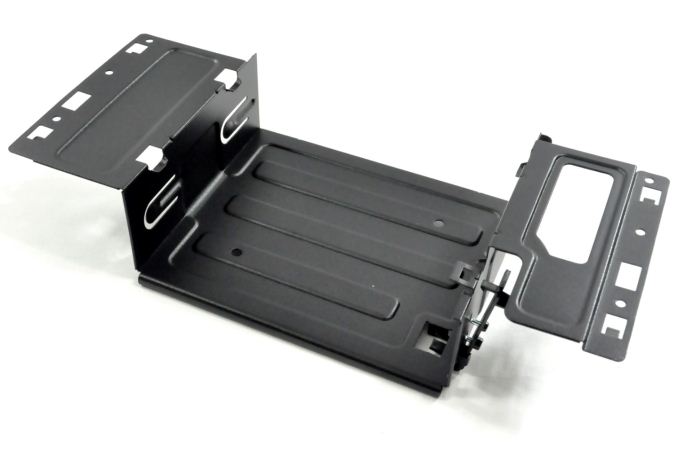

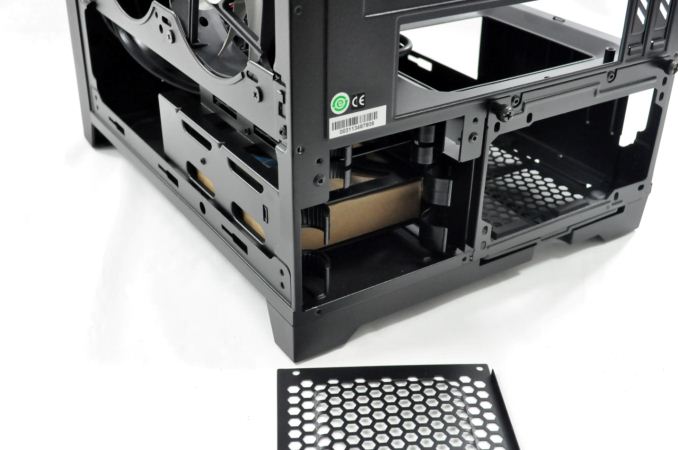
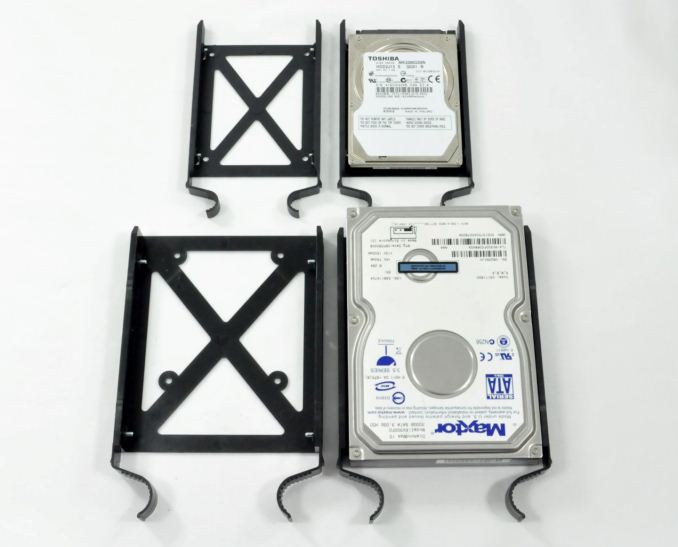
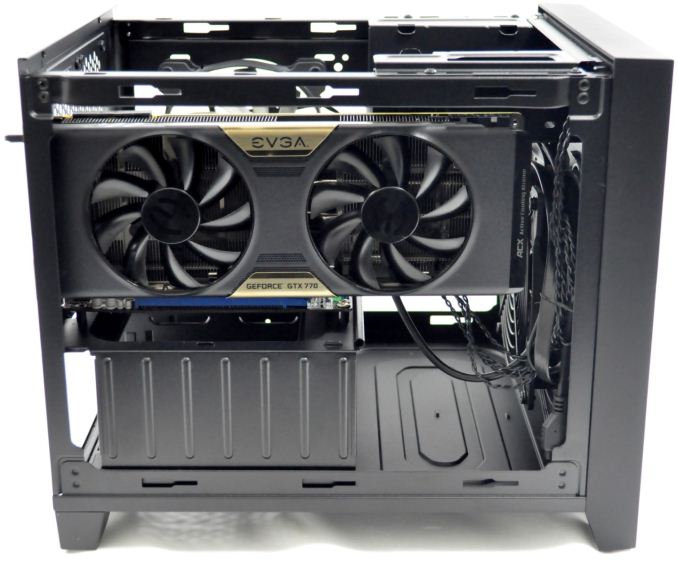
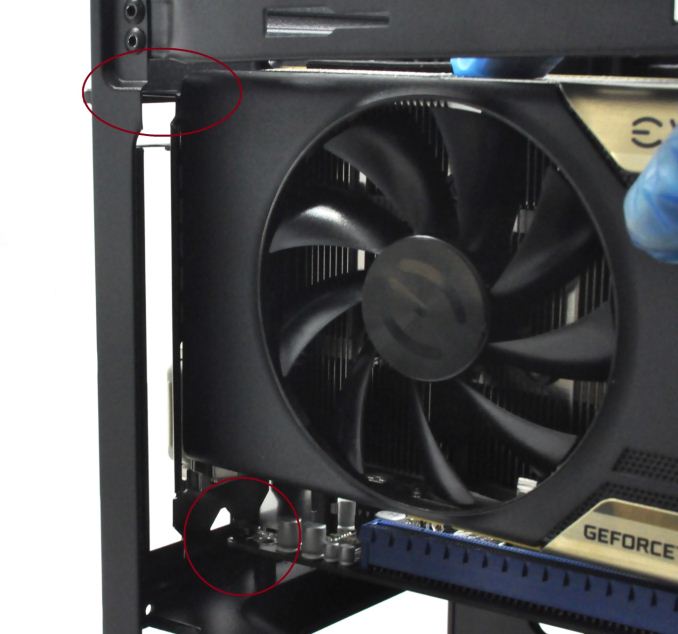
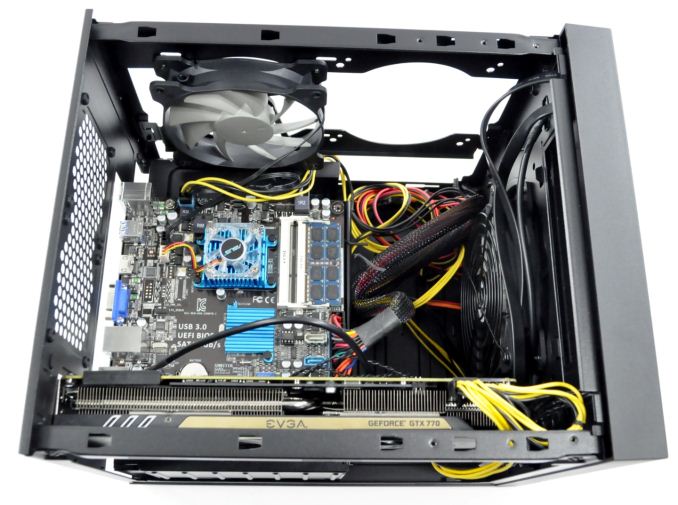








52 Comments
View All Comments
JDG1980 - Tuesday, January 21, 2014 - link
I like the idea of using synthetic thermal loads for reliability, but I'm curious how heat is dispersed from these. Do they have metal heatsinks on them like actual components would? If so, do they have pins or fins - and if the latter, what kind of orientation? That can make a big difference - you'll get much better cooling if the airflow is parallel to the fin direction rather than perpendicular. A case with direct airflow (like the Corsair Air 540) will do very well if the video card's fins are parallel to the long side of the card, while a tower with a side fan (like the NZXT Phantom 630) will probably do better if the fins are perpendicular to the slot. How does your current setup take these things into account?E.Fyll - Tuesday, January 21, 2014 - link
Great thinking JDG1980.True, heat is dispersed via heatsinks. Even though the faux boards are solid copper sheets, their surface alone is not enough to disperse such volumes of energy. Unfortunately, they are commercial products and thus they do have fins. I could not find symmetrical heatsinks available commercially and custom constructions would cost a lot of cash. Unfortunately, that was the best I could do with my limited time and resources at this point of time, although the design will gradually improve over time.
The fins of the faux cards are parallel to the sides of the card. The fins of the Mini-ITX board are parallel to the top/bottom sides of the board.
Specifically regarding the GFX card, the design will favor cases which have a fan blowing right at them. However, cases which have no direct airflow over the card slots rely on passive/bulk airflow only, in which case the orientation of the fins would hardly matter.
To summarize, although the fins can work in the favor of some designs, the bulk airflow is far more important as the load does not in any way aids the airflow/heat dissipation capabilities of the case itself, therefore the error is not high.
dbtc - Wednesday, January 29, 2014 - link
I really like the idea behind developing a more consistent testing strategy. The problem I see is that it, although it may provide a very accurate comparison between cases in their true stock configuration, it might not be a good representation real world usage.For example, adding a single fan or changing the orientation of the CPU sink could drastically improve the performance. I think some brief results addressing optimizing the case would be extremely helpful. Not only for providing a more complete review but also for anyone interested in using the case who would like to know which types of components would work best.
I know, it's a lot of extra work - just my thoughts.
jojo32 - Tuesday, January 21, 2014 - link
Is the front of the case damaged? For me, cosmetic defects and rattling parts are so common when getting cases for a custom PC.sor - Tuesday, January 21, 2014 - link
Sort of looks like they forgot to take the protective film off of the front of the case when taking the photos.HaZaRd2K6 - Tuesday, January 21, 2014 - link
It's probably just wear and tear from the case being shipped around to various reviewers.E.Fyll - Tuesday, January 21, 2014 - link
Camera lens overexposure from the overly bright lighting. I am still waiting for a couple of light diffusers. Sorry...There actually is a small dent at the top right side of the front door, as seen in the picture displaying the I/O ports, but this case went through two custom inspections and an intercontinental three working day delivery. The box makes it clear that it has been somewhat mishandled, it has been opened/repackaged twice and the dent is right behind a thick slab of Styrofoam which was undamaged; therefore, my educated guess would be that the dent was caused by the inspectors or during shipping, rather than on the factory floor.
jojo32 - Thursday, January 23, 2014 - link
Thanks. I didn't think of lighting. Then again, I'm not a photography enthusiaist. I think my phone takes great pictures.I never had a Corsair case but cosmetic defects from manufacuturing, damage from shipping and loose parts happen so often when I bought cases from other companies (BitFenix, Cooler Master, Silverstone and Lian Li).
stratum - Monday, January 27, 2014 - link
Same here. I'm more likely to get damage, loose parts and cosmetic defects than not. Even the $100+ "premium" cases are like this.BigLeagueJammer - Tuesday, January 21, 2014 - link
I'd like more information about the new thermal testing. I thought there wasn't much information for something that's a new concept compared to putting a real system in there. Overall I found it rather confusing and borderline useless.